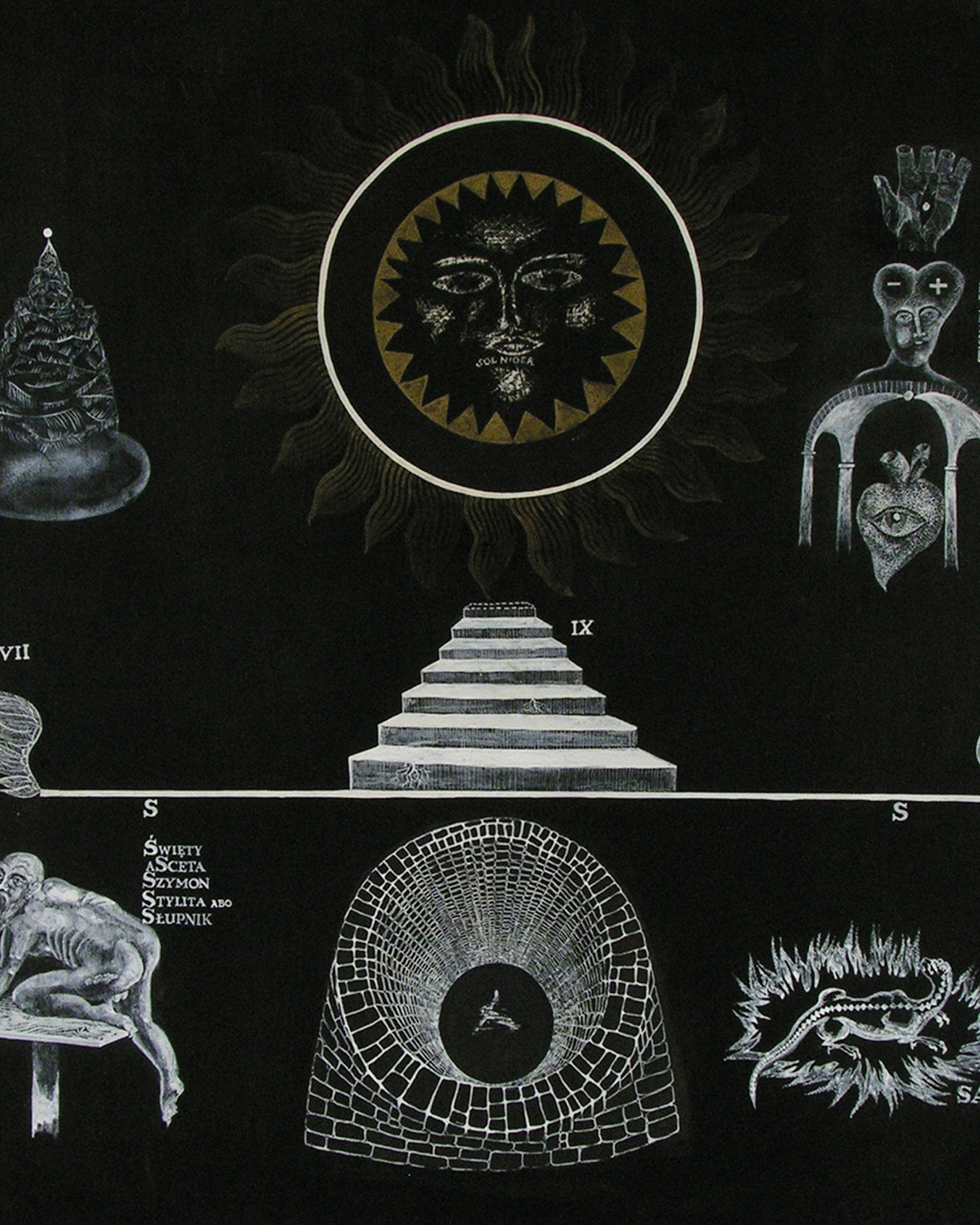
16 Dec Oneiron – CHAOS or Black Cards.
CHAOS, or Black Cards. The secret chronicle of a group of friends later called the League of Spiritual Observations or Oneiron lists December 23, 1967 as the day they decided to jointly create something called first a lexicon, later the New Casual Holy Scripture in Images, and still later the New Casual Chaos in Pictures. It’s hard to talk about the purpose of the undertaking. Maybe there wasn’t one. Maybe the entire goal was exhausted in the action, in mutual confessions, disputes, games, and coexistence. Maybe it’s just a testimony, a record of their interests, views and longings of the writers. The first show took place on October 11, 1969 during the 2nd Katowice Meeting of Creators and Theorists of Art. The second in April 1970 at the Contemporary Gallery in Warsaw. The Third, at the EM Club Gallery of International Press and Books in Siemianowice Slaskie, where the group first officially appeared under the name Oneiron.
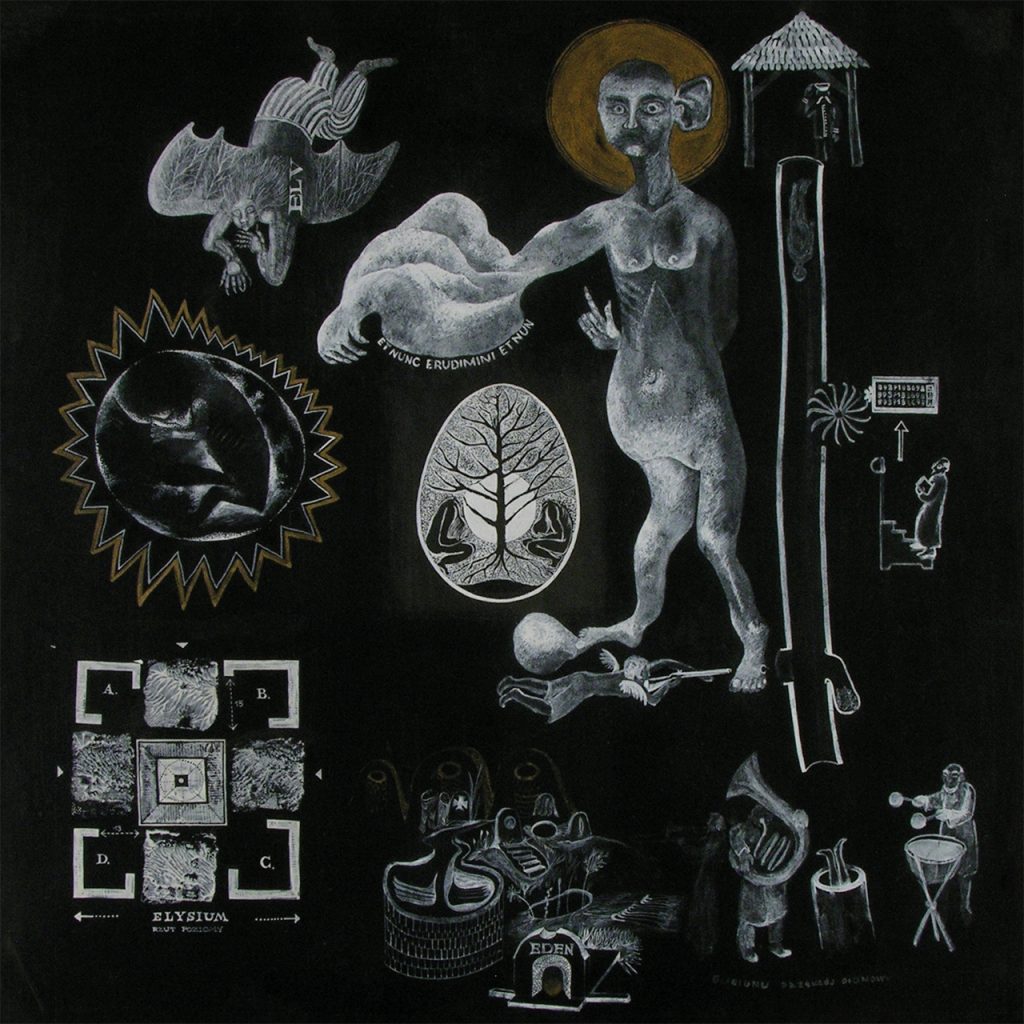
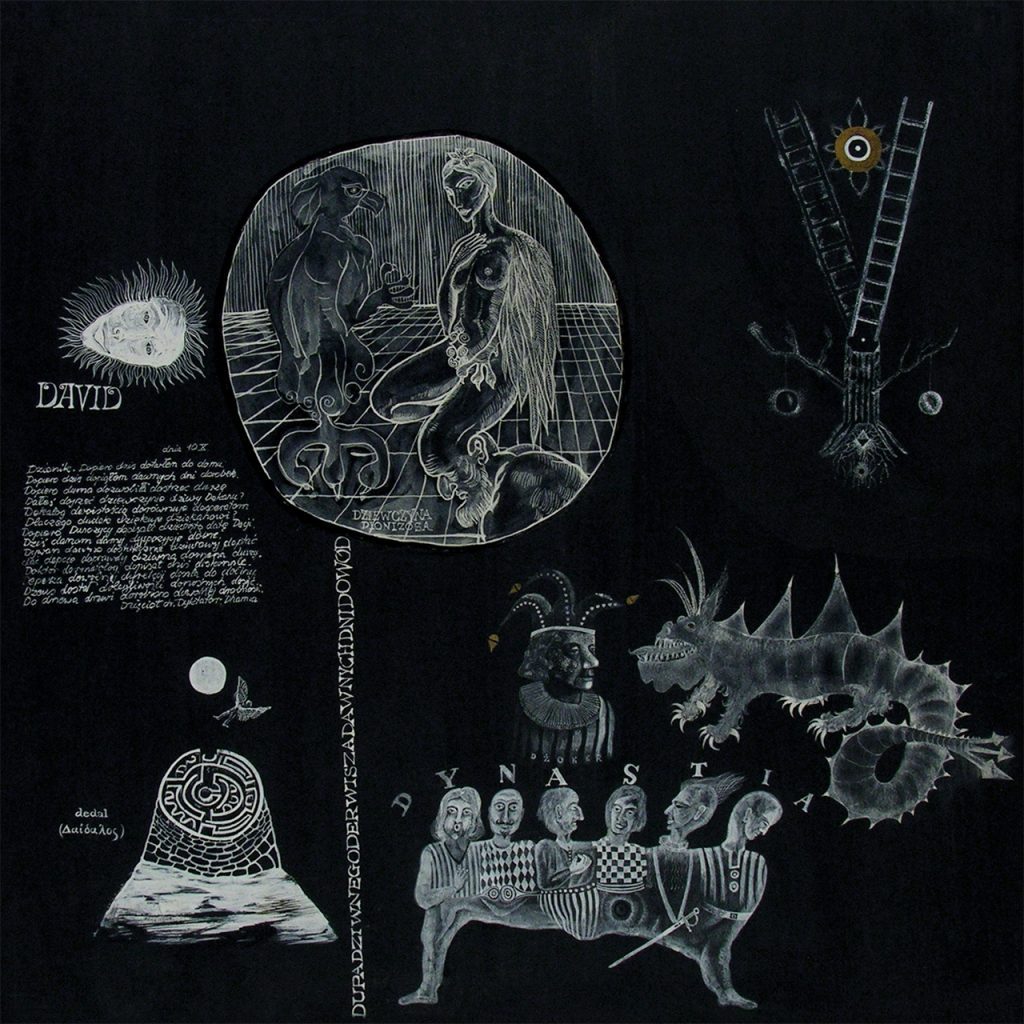

The series of Black Cards , was initially called “Encyclopaedia” or “Lexicon”, later “New Unpretentious Holy Scripture in Pictures” or “New Chaos in Pictures”, was created from December 1967 to October 1969 by five Upper Silesian artists: Urszula Broll, Antoni Halor , Zygmunt Stuchlik, Andrzej Urbanowicz and Henryk Waniek. The Oneiron Circle (Greek: òneiros – a dream) took place in the art studio of Urszula Broll and Andrzej Urbanowicz at ul. Piastowska in Katowice. The Oneiron Circle, first called the Secret Chronicle of Five People or the League of Spiritual Observations, was realised in joint artistic activities in the years 1966–1975, primarily in Dadaist happenings ( e.g.martyrdom and death of Joan of Arc , Salvador Dali ), mystery shows, and above all in the mysterious project of Black Cards.
The principles of the project were defined at a meeting of five project participants on December 23, 1967. The most important element of the game of the Black Cards series were the letters and the content of the paintings associated with them. In total, there were thirty cards of 70 × 70 cm (only a card of this size could be purchased at that time). Each of the project participants had six cards drawn at random with letters assigned to them and had the privilege of painting the central pictogram, proposing the card’s main slogan. The cards were passed to each other, and the choice of the artistic form and content of the pictogram was an individual decision of the project participant. Each of them had to put a pictogram or an inscription on the card at least once, which referred to the letter of the card’s alphabet.
The background of each card was the glossy, strong black of black draftsman’s ink. There are drawings, pictures, symbols and sentences (hereinafter referred to as pictograms), painted with white Perła drawing ink and Talens poster paints in silver and gold. All pictograms are placed in the same foreground. They were drawn precisely, with details, like things viewed in full light, at close range. Some were only outlined with a clear white outline, emphasizing their contrast and simplicity. Others are shaped by a gradual gradation of gray and white color, entering into a silvery luminosity. Only exceptionally the surface of some was covered with gold. The inscriptions were applied in a neat, legible handwriting. The pictograms were placed on square planes without any formal or content relationship, ignoring the rules of proportion and the classic composition of the picture. Thanks to this, the effect of chaotic pulsation of white-luminous forms was obtained, which seem to emerge from a black, shiny background, emerge from a black abyss or penetrate into this abyss.
The very idea of painting the series of Black Cards was to some extent a continuation of André Breton’s (1896–1966) thought about art and magic. He believed that the magic drowned out by the development of civilization was rediscovered by surrealism. The magical worlds of imagination, liberated from the aesthetics, ethics and ideology of bourgeois society, should appear in imaginative art, especially in painting and poetry. At the conclusion of The Second Manifesto of Surrealism (1930), Breton demanded a deep, true occultation of Surrealism and emphasised the importance of surreal parlor games, collective drawings leading to “the possibility of forming a common thought”5. Henryk Waniek wrote about the artistic and ideological links between the Oneiron Circle and surrealism in 2001: “If we were to look for some parentage for this project of ours [ Black Cards ], perhaps it would be echoes of surrealism, which we respected unanimously. Especially its late phase, when in the fifties Breton succumbed to the spell of the occult and magic.
The pictograms on the black cards resemble the surrealist experiments of cadavre exquis (delectable corpse), during which three or four people created a joint drawing. It was an old children’s game adapted by the surrealists around 1925 for artistic activities that were supposed to make people aware of “the connections between the external and internal world”. Surrealists were interested in the creative process itself, automatism, turning off the critical mind and opening its metaphorical abilities.
Cadavre exquis drawings , interpreted in terms of Sigmund Freud’s (1856–1939) psychoanalysis, the concept of drives and dream analysis, were for the Surrealists a symbolic key to the world of the unconscious. Other than the consciousness-expanding action of creation, these shared drawings had no other purpose; the time, place and number of participants in the game were random. Cadavre exquis drawings often illustrated various periodicals, manifestos and surrealist prints.
The action of creating the Black Cards series was inspired, apart from the aforementioned cadavre exquis drawings , also by certain ideas of Carl Gustav Jung (1875–1961), especially the concept of primal images recorded in the collective unconscious and containing fundamental human experiences. Jung’s belief that the metaphorical content of archetypes cannot be logically verbalized but only represented by symbols, which in our inner world is the only reality, was of significant importance for the project of the Black Cards . These symbolic images that connect the unconscious with consciousness, hidden with the open, darkness with light, were to be sought in dreams, myths and visions, in spontaneous artistic creation. In this context, the series of Black Cards , seemingly giving the impression of total creative nonsense, gained new values, offering the viewer a different sense of understanding the reality and metaphorical nature of the image, and a different, symbolic meaning of Chaos.
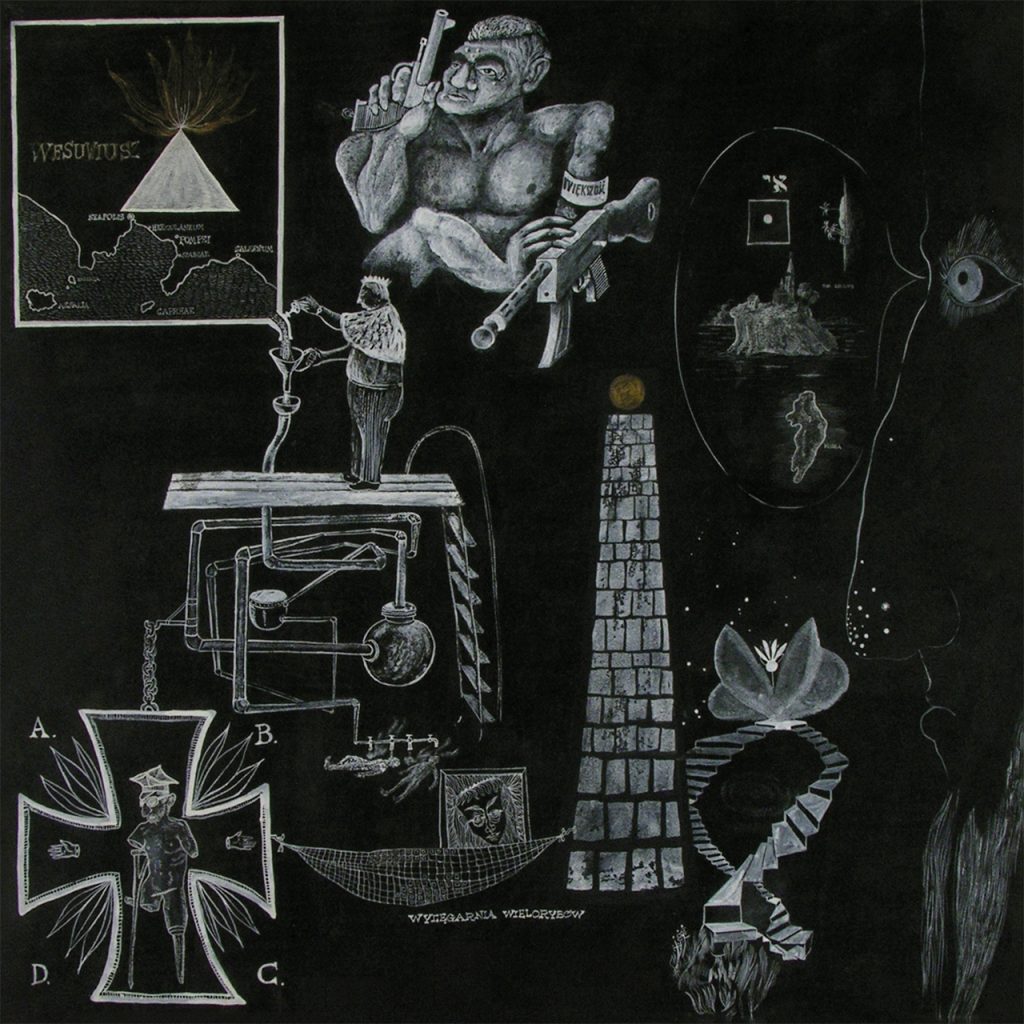


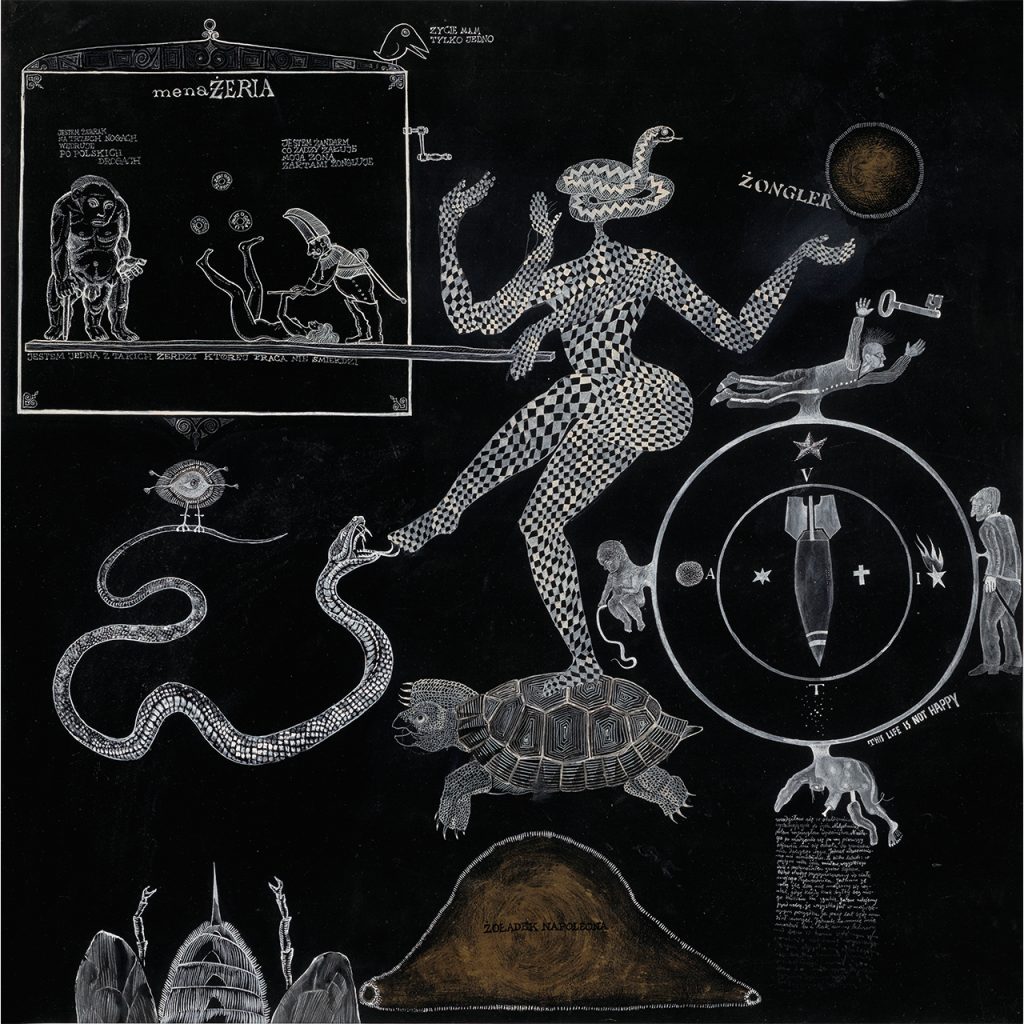

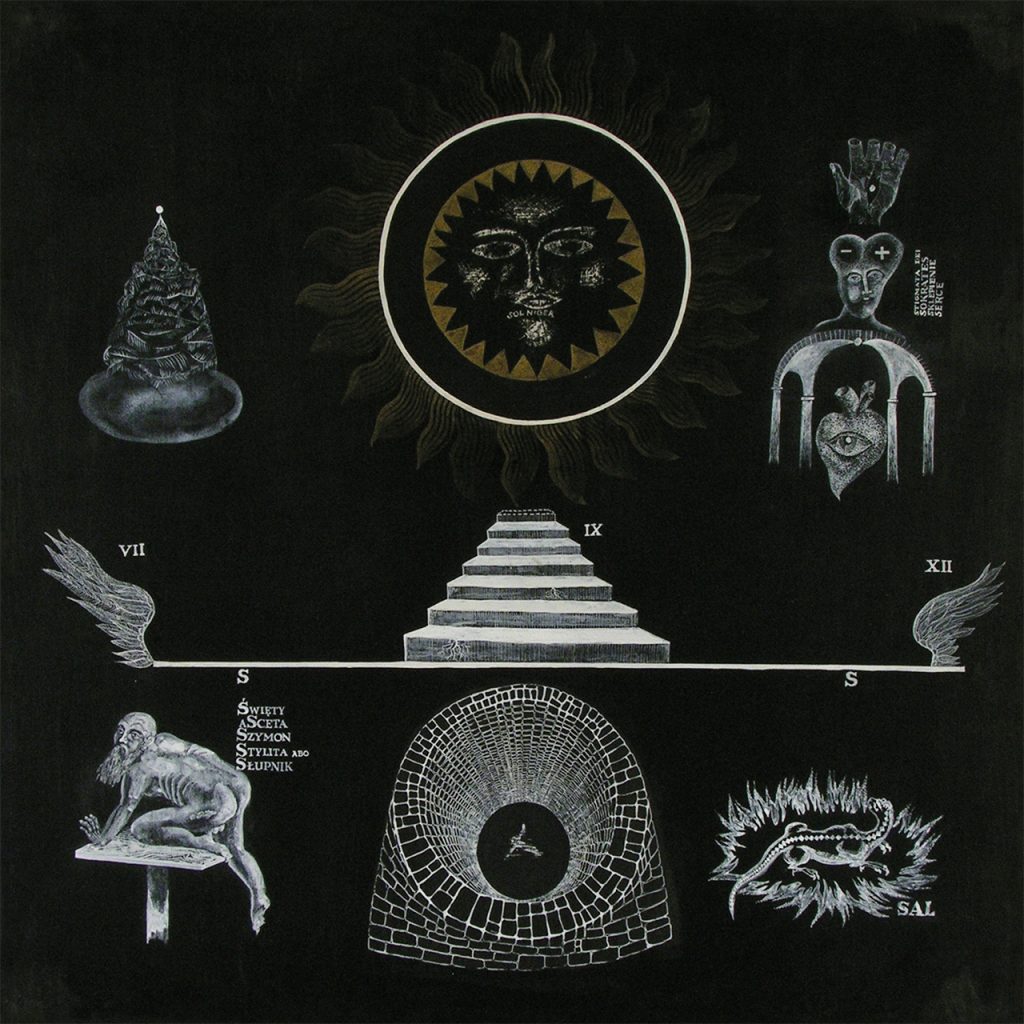




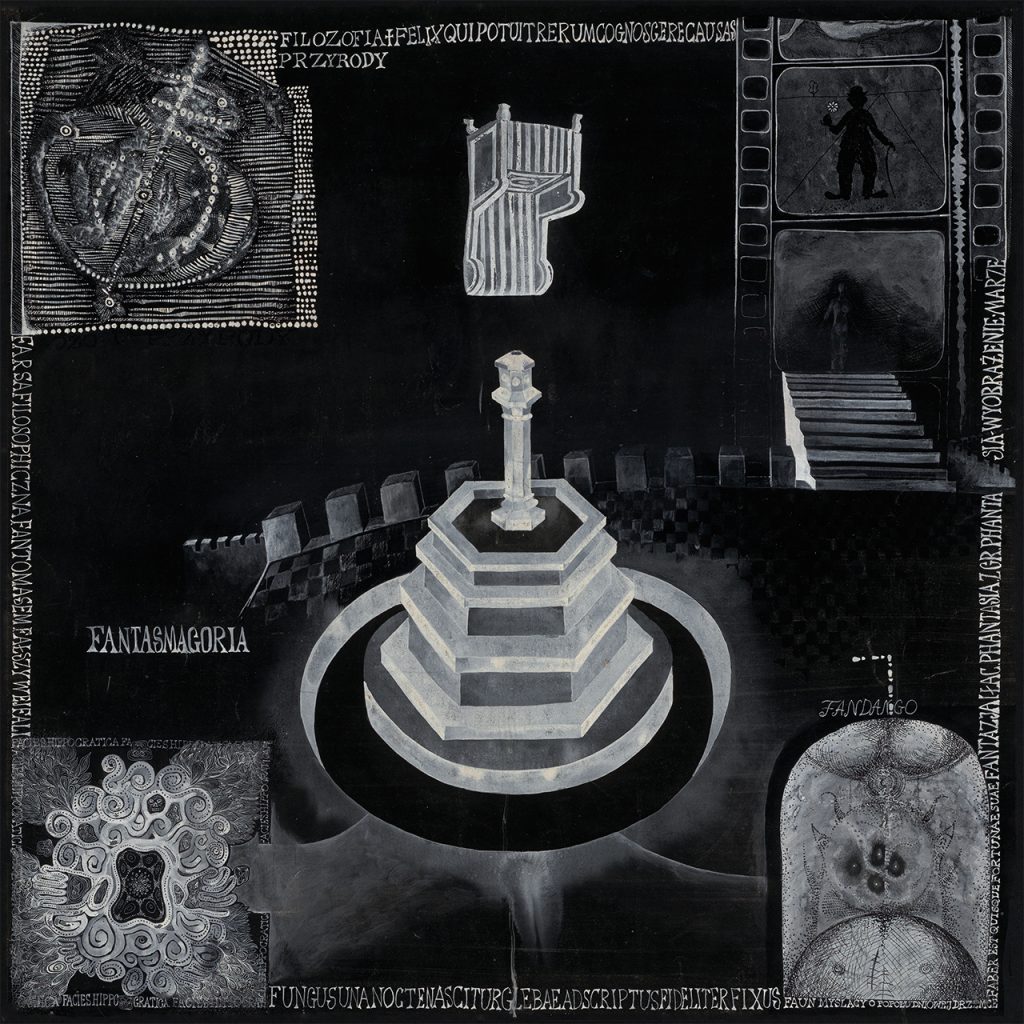

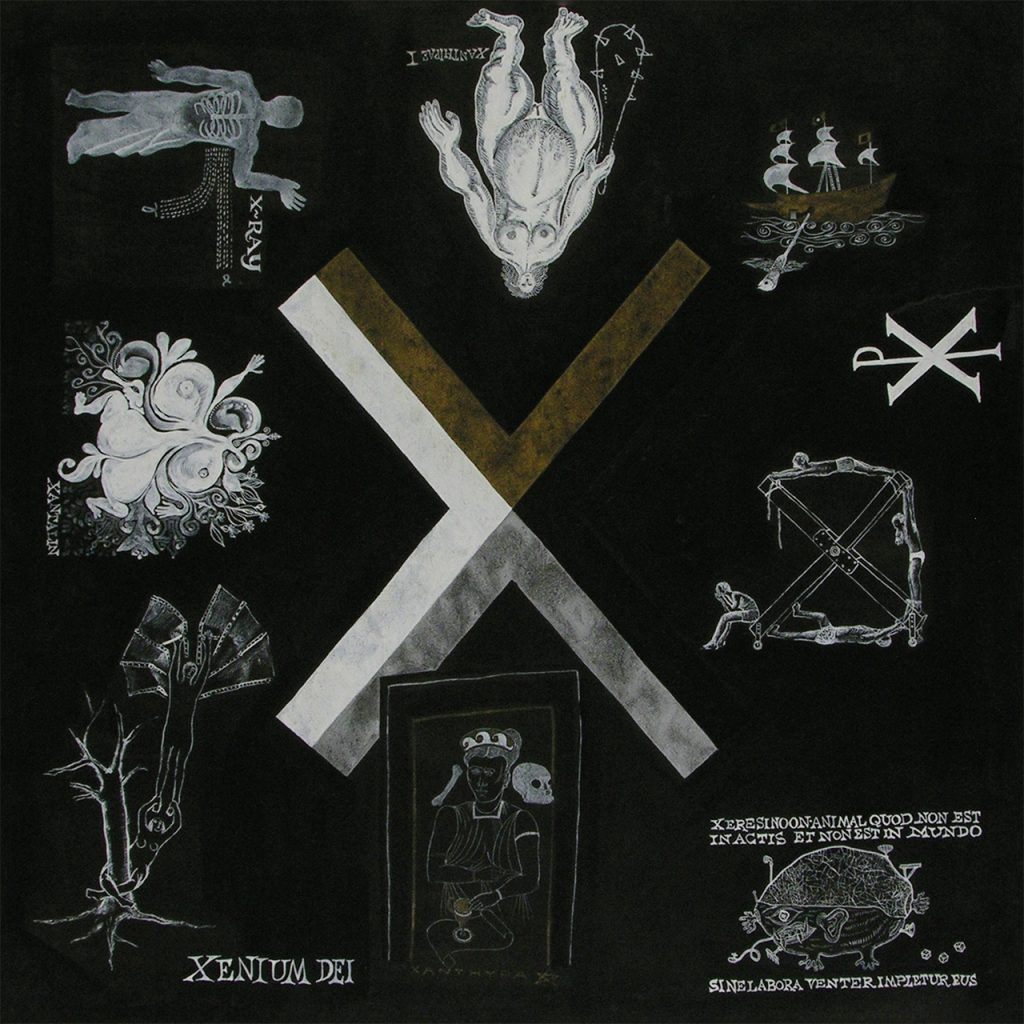



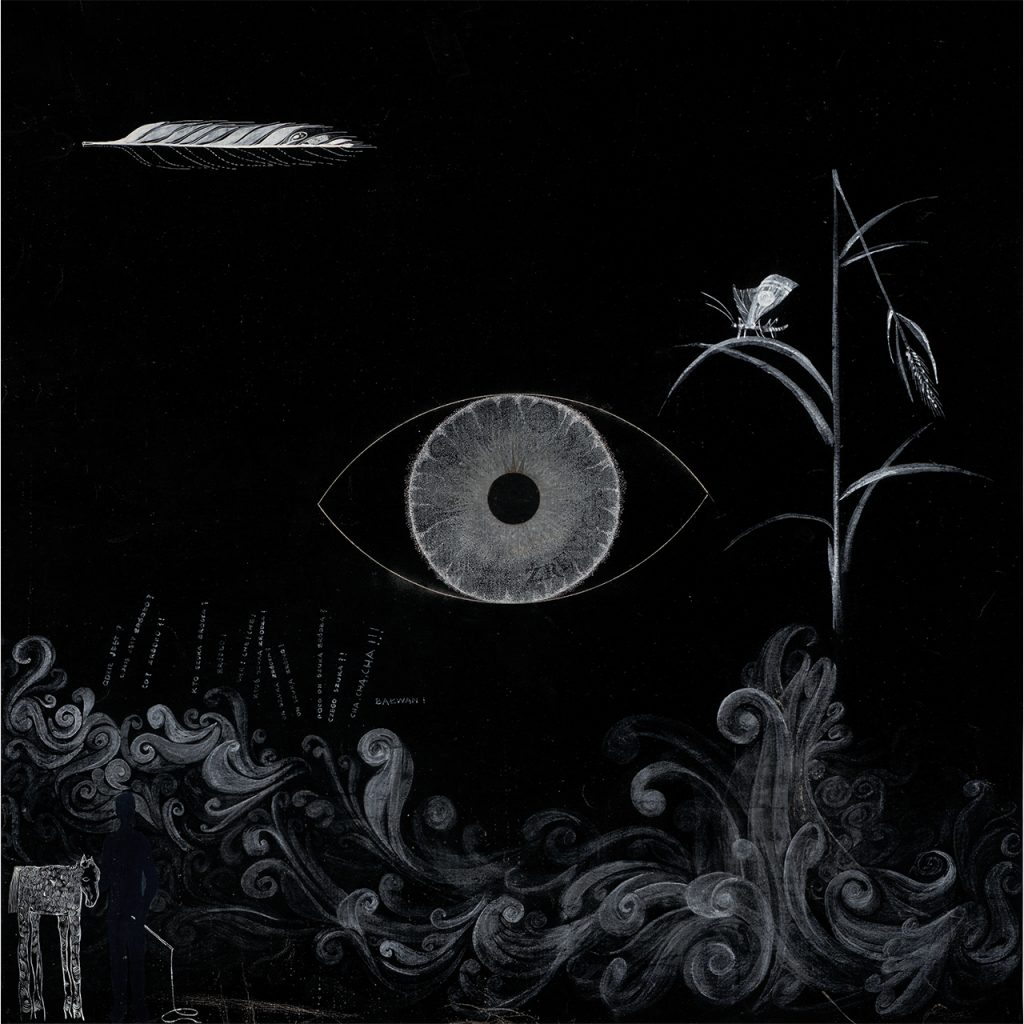


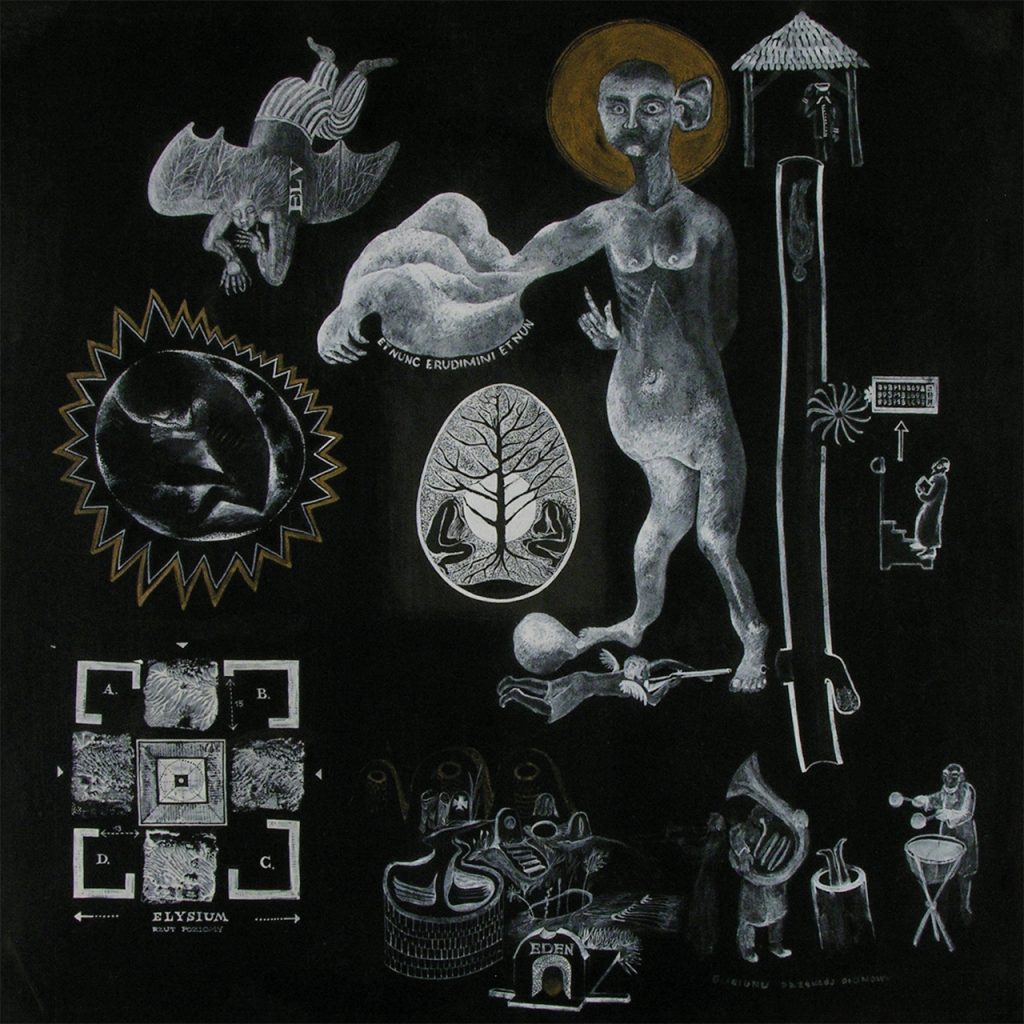

The choice of the alphabet, the link connecting and ordering the Black Cards , referred to the mystical Kabbalah, especially to the vision of the creation and existence of the world. The analogies of the idea of Kabbalistic cosmogony and the concept of Black Cards confirm the interests of the participants of the Oneiron Circle in Kabbalah. At the turn of 1965 and 1966, Urbanowicz developed five didactic boards devoted to Jewish mysticism.. In Kabbalah, words and numbers (Hebrew letters also have numerical values) are the elements that connect the spiritual and material worlds. By creating magical combinations of letters, God the Creator (YHWH) gave names to the entire real world. The letters of the Hebrew alphabet became the instrument of the revelation of reality. The letters of the Polish alphabet played such a symbolic role in the Black Cards project. The pictograms created by the painters of the Oneiron Circle, associated with letters and ideas (names), symbolized the act of creating an artistic vision of the world. The blackness of the cards corresponds to the Kabbalistic darkness from which three Hebrew mother letters emerged: shin (fire), alef (air), meme(water). In Kabbalah, darkness hid the secret of the revelation of the world, just like the blackness of the Black Cards , which hid the secret of the artistic record.
According to the mythological tradition, the series of Black Cards was a kind of artistic cosmogony. In several dozen visions of the creation or creation of the world, occurring in various ancient cultures on all continents, especially in Greek mythology, at the beginning before the creation of the Cosmos (Greek kósmos – order, divine proportion) there was Chaos (Greek cháos – gaping, gaping abyss, emptiness ), eternal darkness, full of primal energy and creative forces, disordered pre-matter from which the world was created. The background of the Black Cards also has such a symbolic meaning of the state before the creation of the world . From the darkness and nothingness of Chaos (black cards) came light, a bright day, the moon and the sun (macrocosm), which on the cards symbolize the colors of the pictograms: white, silver and gold. The composition of most Black Cards refers to the cosmogonic symbolism , which resembles the form of a mandala or a labyrinth, universal pre-images already known in cave painting. These forms have always had mystical and ritual significance. In the Oneiron Circle, interest in the problem of the symbolic meaning of the labyrinth dates back to at least 1966. The composition of the Black Cards was created from the inside, in which a symbol-pictogram, dominant in content and visually, was placed, often circular (a circle as a symbol of the universe), with a brighter color. Similarly, in the composition of the mandala, the central point (center) was the beginning and the end, the axis of the cosmos. Mandala combined creative energy and was a mystical metaphor of the Cosmos, a symbol of its harmony, and the opposite of Chaos, this shapeless black mass – it was an archetype of searching and striving for perfection (Jung). The fascination with the form and symbolism of the mandala was also of great importance in the individual work of the painters of the Oneiron Circle, especially in the works of Broll and Urbanowicz.
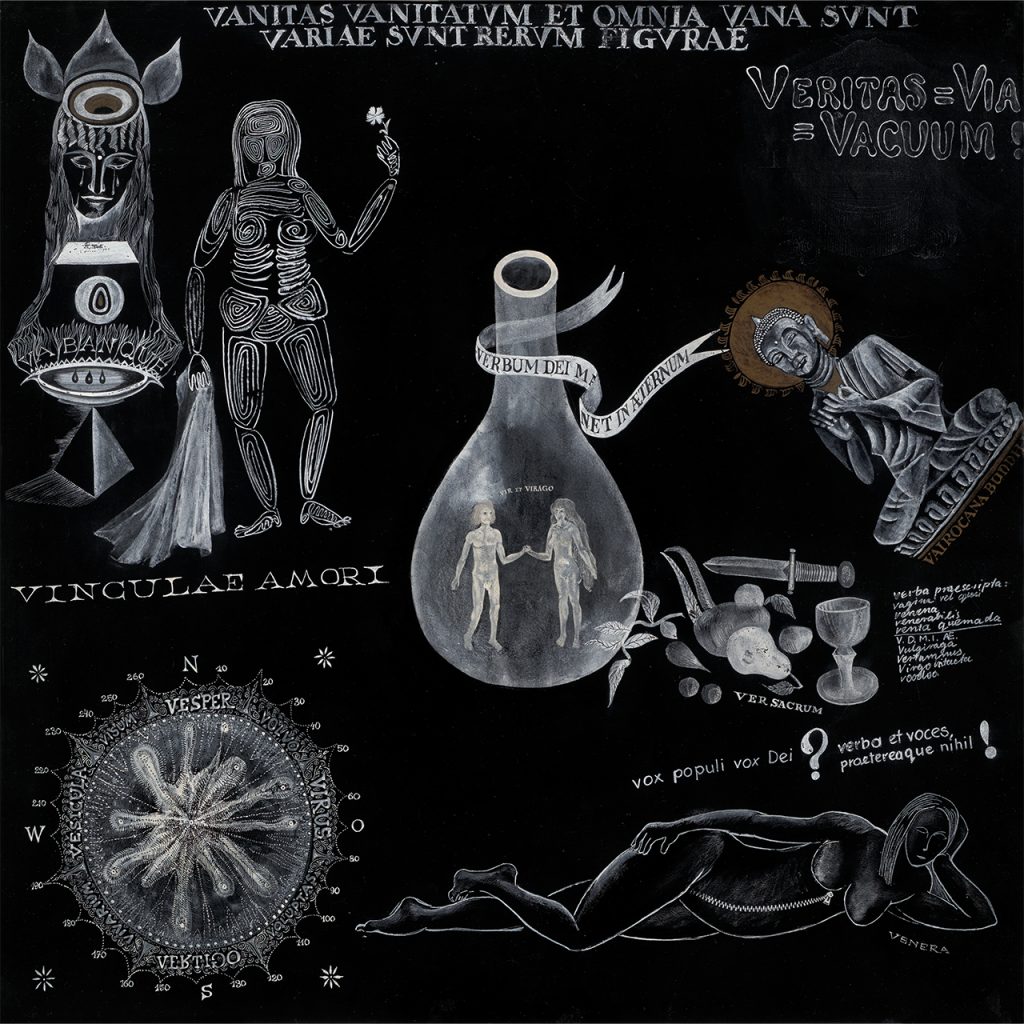

For the concept of the Black Cards cycle, the alchemical, mystical process of moral and spiritual development of an adept of secret sciences called the Great Work ( Opus Magnum ) was of decisive importance . The alchemical life of man was a labyrinth, a journey that was supposed to lead to a luminous spiritual center. The process of the alchemist’s internal transformation began in Chaos ( Materia Prima or Nigredo – “blackness is blacker than black”) and sought spiritual illumination. The white-silver color of the illumination (called the White Rose by the alchemists) ended the first stage of Opus Magnum . Gold symbolised the mystical Sun, the highest degree of inner enlightenment, the state of glory, the philosopher’s stone ( lapis philosophorum ) or the elixir of life giving immortality. The state of highest illumination of golden fire, called the Golden Rose, was a reward for the suffering caused by mystical detachment from the real world and total dedication to the Great Work. The mystical light of alchemy, similar to the light on the Black Cardswas not a physical illumination of the real world, but a revelation of the spiritual reality hidden in it.
From the turn of the 19th and 20th centuries, literature, philosophy, science, music, and especially visual arts drew creative ideas from the esoteric vision of the world. The source of this type of creativity was the idealistic concept of aesthetics created by Plotinus in the 3rd century, according to which beauty is the revelation of spiritual light in the sensual world. Simple things are beautiful: pure color, sound, light, brilliance. The artist is looking for an “inner shape”, because his imagination goes beyond natural patterns and reaches the deep essence of reality. Black Cards with the ideological and artistic reality discovered in them belong to the trend of spiritualist art, just like cave painting, Byzantine mosaics or Ruthenian icons.
At the end of our considerations, it is worth quoting the description of the opening-show of Black Cards , which took place on October 10, 1969 in the attic at ul. Piastowska in Katowice. Only invited people, sympathizers of the Oneiron Circle, attended this meeting. The mystery show was prepared by Andrzej Urbanowicz and Henryk Waniek. The interior of the gallery-attic was lit only by candles, and the chaotic sounds of music were heard from the speakers. Black Cardsthey were placed chaotically between various objects, forming a kind of altars. The participants of the show began to bring all these objects and lighted candles to the central place – in front of the image of the divine Hermaphrodite. In this way, they ordered the chaotic interior and erected a kind of altar lit with many candles for the hermaphrodite goddess, who in alchemy expressed unity, the union of opposites ( coincidence oppositorum ) and – like Rebis or Mercury – was the personification of the philosopher’s stone. Urbanowicz noted that night: ” Black Cards and the special mood of that evening emanated with holiness”.
Various ideas and visions have been woven into the fascinating magic of the space of the Black Cards : the concept of Jungian archetypes and symbols, mythological cosmogony, connections between the alphabet and Kabbalah, the symbolism of the mandala and labyrinth, the alchemical process of human spiritual development, as well as Dadaist mockery and mockery. The shape of artistic expression realised on their plane was determined by the Neo-Platonic concept of spiritualist aesthetics and the surrealist formula of the magical nature of art. Created for almost two years, the Black Cards gained autonomy and spirituality. For the iconology of art, this project rediscovered and defined the artistic and spiritual value of Chaos – black, without which nothing can be created – as a synonym of imagination. And almost three hundred pictograms of cards revealed in black form a great fresco telling us that the whole world that exists in our consciousness is just a game of our imagination
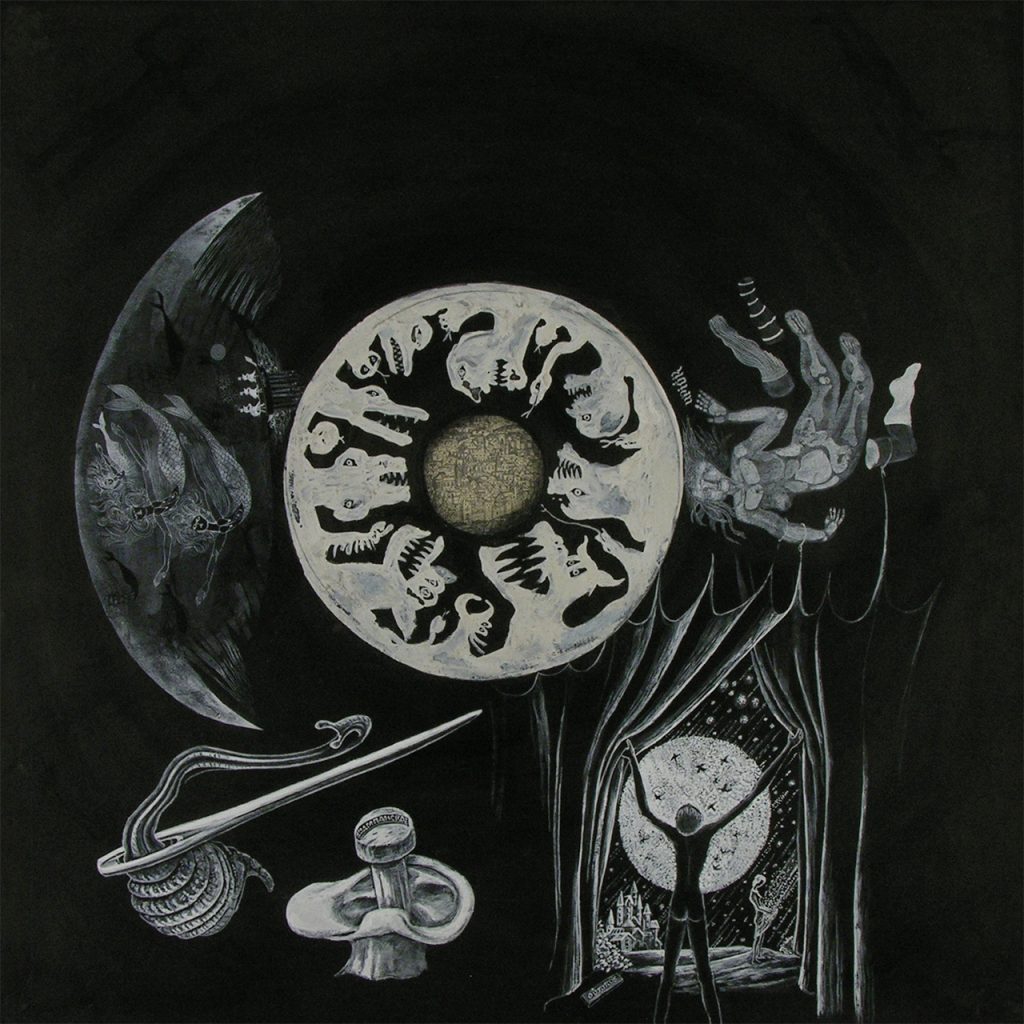




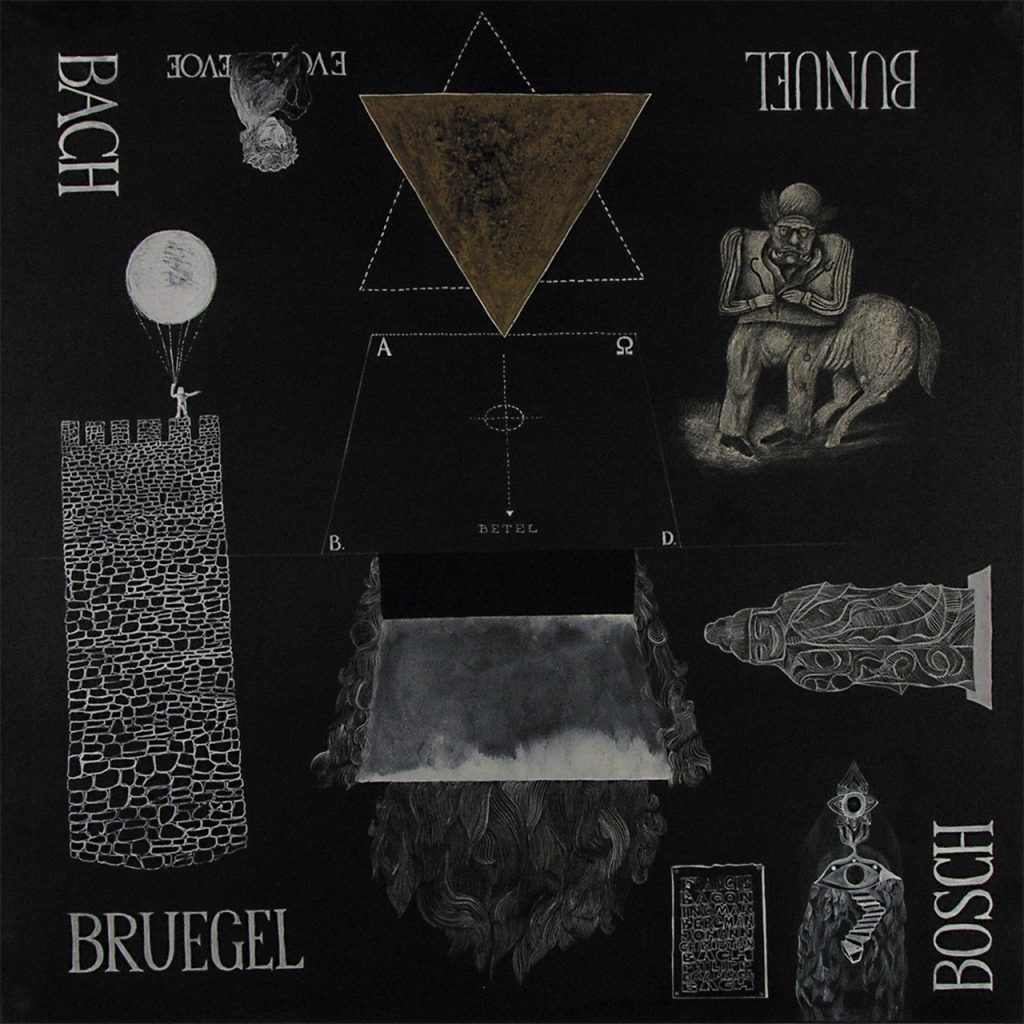












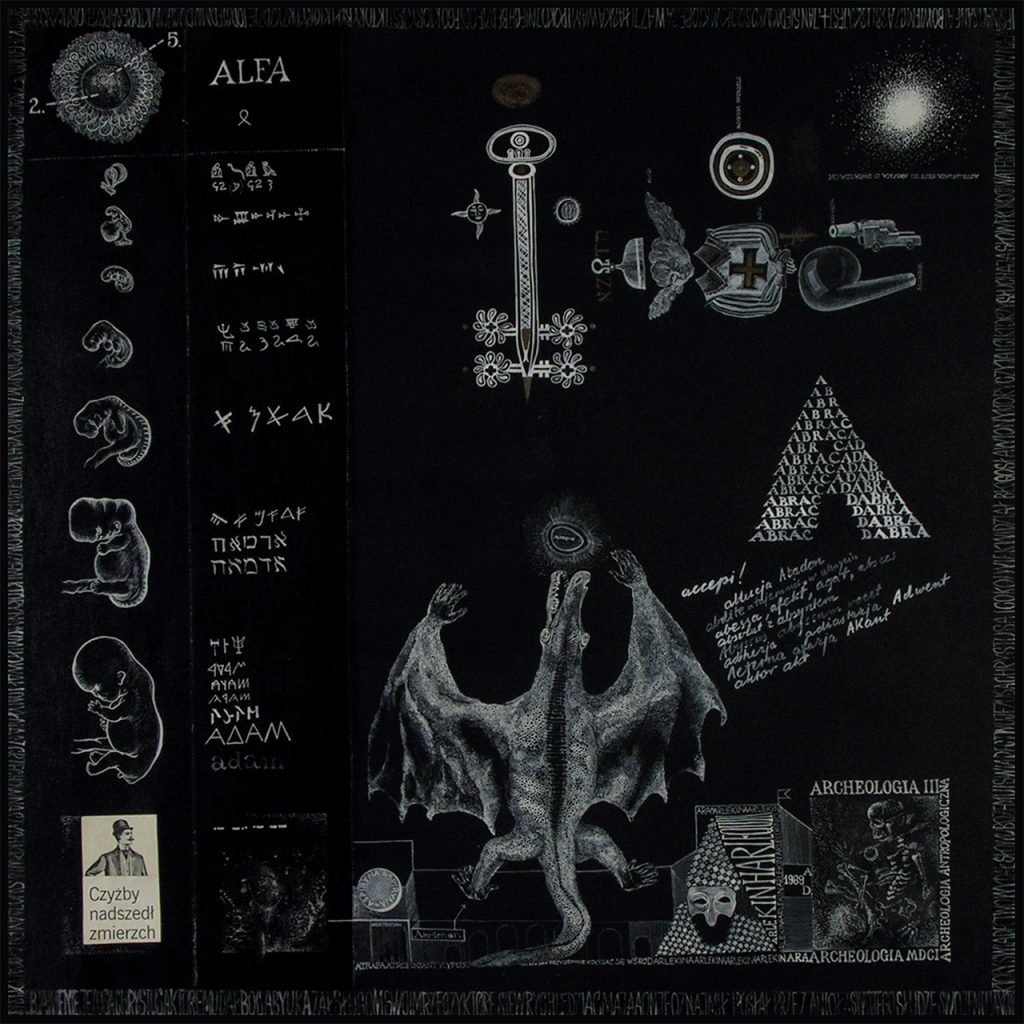


No Comments